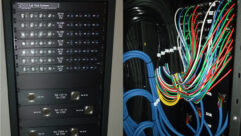In the last section, we discussed how the technical ground system is delivered to the equipment via the ac outlets in the system using the equipment ground contact (third prong) of the equipment power cord.
With this ground system now in place, it is necessary to implement the remaining measures to ground the cable shields and other elements of the audio and video systems.
Shields
In the last couple of years, there have been a number of interesting developments in the area of cables and cable shields. Most of these ideas are in the reference work published by Neil Muncy in the Journal of the Audio Engineering Society in a paper titled “Noise Susceptibility in Analogue and Digital Signal Processing Systems” (Muncy, 1995). In this paper, Muncy evaluates the cause-and-effect relationship between a popular and widely employed equipment-design practice and electrical noise problems in audio systems.
In presenting these ideas, Muncy goes back to first principles and discusses all aspects of EMI problems related to cables, cable shields and their termination. Readers interested in this topic are urged to review this paper. Many of the ideas presented in the following are found therein.
One of the most interesting developments is that the current flowing in the shield of a cable is not particularly important with regard to the induction of noise into signal wiring and circuit inputs. To understand this, we must realize that when a ground loop is created, because a shield is terminated at both ends, the current in this ground loop flows through the shield and through the ground conductors that form part of the technical ground system.
In the past, it was generally thought that the current in the shield induced electromagnetic interference in the signal conductors contained within. The current in the ground conductors was also thought to create noise because it was modulating the ground reference of the equipment. Muncy has done tests that indicate that, for most modern cables, the noise induced into the signal conductors of a cable because of shield current is insignificant, at least for those systems that have less than 90dB of dynamic range. This means that ground loops created by shields do most of their damage because of the current they create in the other technical ground conductors that form part of the loop.
This is an important point, particularly in light of the fact that the shield of a cable is relatively less important with regard to EMI than, say, the twisting of the conductors within. (Note that the telephone company operates with unshielded, twisted-pair cables with great effectiveness, and the use of unshielded cable has other advocates.) Given this, then, it is extremely important that we do not introduce ground loops because of these schemes when we implement shield grounding schemes. As the shield ground seems to be of limited importance, the last thing we want to do is to create additional problems because of its existence. Therefore, one of the main criteria in developing shield grounding techniques and termination methods is that they avoid ground loops.
In the case of coaxial cable, the shield serves several purposes. It provides a transmission line of constant and specific characteristic impedance—usually 75 ohms. It shields the signal conductor within and provides the return current path for this signal cable. This system creates ground loops at every turn because a shield is normally terminated (to ground) at both ends for there to be constant characteristic impedance and a signal return path. Video systems today are fairly resistant to low-frequency hum often associated with these types of ground loops, and a number of techniques are used to overcome problems associated with these ground loops when they do occur. This, however, does nothing for the associated audio equipment that might be operating near the video equipment and affected by the ground loops created. A technique for dealing with this problem, segregating equipment, will be discussed later.
A helpful idea to keep in mind when analyzing the problems of shield grounding schemes for shielded twisted pair is to remember that the connections of the shield in a twisted-pair cable usually have little to do with the connections of the signal conductors within. Depending on the format of the audio interconnect, be it balanced or unbalanced or transformer or electronic, there are different ways to terminate the signal wires. These have nothing to do with the method used for terminating the shield. These are two distinct problems and cab be analyzed and resolved separately.
With the notion that ground loops are problematic because of the current that they create in ground conductors, and given that ground conductors will be shared by certain pieces of equipment in an equipment cluster, it is obvious that a ground loop created by one piece of equipment may have an impact on the noise of another piece of equipment. Because of this, it is often difficult to track down noise problems associated with ground loops. For this reason, it is absolutely paramount that every precaution be taken at the wiring stage to eliminate the possibility of any shield becoming inadvertently grounded, be it grounded to the connector shell, the conduit system or the technical ground system. For this reason, neat and professional wiring practices are critical to the success of an audio installation. It has been my experience that it takes several years of full-time wiring practice for an installer to develop the necessary skills and understanding to provide reliable and fail-safe wiring.
Types of systems
The ground shielding scheme you use will be determined by the type of system you are working with: fixed or flexible layout systems.
–Fixed layout systems are permanently wired and have no built-in ability to be repatched or reconfigured, usually by the use of a jackfield or some other patching arrangement. In the case of fixed layout systems, the task is fairly straightforward with regard to shield connections.
The rule for grounding shields is to ground the cable shield at one end only. This is often called the OEO rule. Whether to ground at the input or the output has been the subject of much discussion. This author recommends grounding at the output as a general rule. This is because outputs are never looped together, and thus we avoid the possibility of ground loops that could thus be created. Inputs are often driven in parallel, particularly in voltage source systems, and this would require exceptions to the rule if grounding were done here. In the case of unbalanced signal connections, such as single-ended hi-fi audio connections or video cable connections, both of which commonly use coaxial cable, the shield also forms the return conductor for the single signal conductor. In this case, obviously, the shield cannot be lifted, and a ground loop is formed.
–Flexible layout systems use jackfields or other patching means to allow reconfiguration of the system. The use of patching greatly complicates the shield grounding scheme. (See Figure 24.) This figure illustrates a pair of outputs normalized to a pair of inputs. No ground loop exists until a patch cord is in place between one of the outputs and an input. Then, as shown by the dotted line, a ground loop is formed because of the way the shield grounding was handled at the jacks. In this case, it was carried through the jacks. Many ways of implementing grounding schemes through jacks will cause ground loops. Any proposed shield grounding schemes should be drawn out and analyzed.
Note that if the jacks are treated as a piece of equipment, where the shields are either grounded or lifted, the loop is avoided. (See Figure 24B.) This technique is illustrated in Figure 25.Other considerations
With the problem associated with coaxial video connections and the ground loops thereby created, it is often appropriate to segregate the equipment into separate racks and to provide individual isolated ground conductors to these racks from the main ac distribution panel. As a result, the ground loops created by the video system are isolated as much as possible from the more sensitive audio system. This idea can be taken one step further by segregating less sensitive systems, such as intercom or signaling systems, and locating this equipment in other racks as well.
Therefore, in a facility you may have racks containing exclusively audio equipment, other racks containing video equipment and other racks containing intercom or control equipment. Each of these three rack systems would be freestanding on its own isolating base and fed from power with dedicated technical ground conductors from the local power-distribution point.
As we enter the digital age, the differences among all of these types of signals diminish because they all become bitstreams. However, the sensitivity of digital signals to EMI problems associated with ground loops is at least as critical, if not more critical, as it is in analog systems.
Another helpful technique is to group the grounds. The loop area of a ground loop will determine the extent of the current that may be induced into it by nearby magnetic fields. If the ground wires associated with equipment in a rack are grouped together and run parallel, then the loop area will be minimized. These ground wires could be twisted together, thus eliminating the loop area of this portion of the circuit to zero.
In the case of very long runs, (such as those used in theme parks or large sports facilities), or where there are very high EMI fields (such as in the case of nearby RF transmitters), it may be preferable not to terminate the cable shields to the electronic equipment at all.
Instead, it can be better to terminate the cable shields at an interim terminal block that has its own dedicated ground conductor back to the local ground bus. This avoids the possibility of the pin-1 problem.
Shield termination
The following rules and comments may be helpful with regard to the use of cable shields.
-Terminate the grounded end of a shielded able with an insulating sleeve over the jacket termination and a piece of tubing over the drain wire, as shown in Figure 26. This prevents the possibility of the shield becoming inadvertently shorted to another circuit, shield or ground.
-The shield must be completely insulated and must not become grounded or sorted to another cable. Keeping the shield insulated is another reason for always terminating the cable with an insulating sleeve.
-In the case of very long cables—more than 1000 feet (305m)—or in very high EMI areas, it might be desirable to break the shield and ground it in two pieces separately. This reduces the length of the shield.
-When terminating shielded cables, always keep the unshielded portion as short as possible, as shown in Figure 26. The unshielded portion should normally be less than 1 inch (25mm) long.
-Never terminate the shield of a balanced audio line at both ends.
-As an alternative to breaking very long shields into pieces, it is possible to use a capacitor as one end of a shielded cable to ground a shield. Then one end of the cable is grounded normally with a direct connection to ground and the other end of the shield is grounded via a capacitor. This provides high-frequency grounding without introducing a dc ground loop. In areas of extreme EMI, this technique may also be helpful on shorter cables.
-Always avoid or minimize unnecessary breaks in shielded cables, such as at junction boxes. You should also always maintain shield continuity and isolation from ground through all boxes or multipin connectors unless the system-design documentation shows doing otherwise.
-Use shielded cables that have a continuous conductive path around the circumference. This is not the case in some cheaper cables in which the coil wraps around the cable and lays the Mylar insulation against the aluminum foil. A fold in the foil is generally needed to ensure conduction at the overlap. Also, the drain wire should lie against the foil side of the shield, making electrical contact. The number of wraps of this shield around the center conductors should also be investigated. Observation will show that cables vary significantly in this regard. Obviously, the more overwrap, the better the expected shielding is.
-Multiconnector, shielded, twisted-pair cable should have an insulated shield and drain wire for each twisted pair of wires.
-Shielded cable may also be used to contain EMI signals. For example, in the case of relay switching or digital control, the shield will help contain the signals and prevent crosstalk into other analog cables.
-Be aware that when a cable specification states that there is 100% shielding, this is an indication of the physical coverage of the shield, not the shielding effectiveness of the shield. A shield with 98% coverage has 2% open in the coverage of the shield. This is often the case with braided shields but never the case with foil shields.










